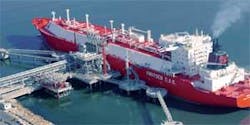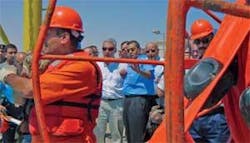Egypt’s Natural Gas Operations and Plans: EGAS guides strategy, Gasco’s expanding grid supplies gas, gas liquids
As the potential of Egypt’s gas resources became well defined and the benefits of clean burning fuel more important, the Egyptian Natural Gas Holding Co. (EGAS) was formed in 1991 by the Ministry of Petroleum to assume the responsibilities of the Egyptian General Petroleum Co. (EGPC) related to natural gas. Now, EGAS supervises and monitors companies involved in gas transmission, distribution and marketing.
Egyptian Natural Gas Co. (Gasco) was born in 1997 to manage, operate and maintain the national gas grid and its facilities, a system that has expanded at a healthy pace. A link between producers and consumers, Gasco is present at every point in the Egyptian gas chain, including transmission, distribution, processing and marketing.
Production and consumption
Egypt’s proved natural gas reserves of 72.3 tcf are up from 53 tcf in 2001, according to EGAS. Consumption has climbed from 17.2 million ton/year in 2001 to 30 million tons in fiscal year 2007. About 60% of the country’s gas is used for power generation, 28% for industry and 10% is recovered as gas liquids. About 3% is used for domestic fuel and to provide compressed natural gas (CNG) for transportation fuel.
Gas exported through the Arab Gas Pipeline totaled about 68 bcf during fiscal 2006, up from 8 bcf in 2003. In 2006, 67 cargos of LNG totaling 3.95 million tons were shipped from Damietta LNG plant. From both trains at the Idku plant, 131 cargos totaling 7.2 million tons were exported. Total LNG exports in 2006 almost doubled from the previous year.
In the Mediterranean, the West Delta Deep Marine (WDDM) fields produce 100-120 MMcfd. Other Mediterranean fields produce a total of 20-50 MMcfd. Nile Delta fields contribute 5-20 MMcfd. And the Western Desert fields produce 10-40 MMcfd.
EGAS projects
At mid 2007, EGAS had five projects scheduled for completion in 2007 and 2008 to boost production and reserves in producing fields. Two projects were for the next phases in the ongoing development of the Rosetta and WDDM concessions; the other three fields have total proved reserves of about 2,600 bcf.
With startup dates as far ahead as 2017, development of new discoveries with total reserves of about 3,630 bcf is also underway at an estimated cost of almost US$2 billion. Additional projects will be contracted to others.
In the Rosetta concession, the third phase will raise production by 150 MMcfd at a cost of US$365 million; a fourth phase will boost gas output by 300 MMcfd when it comes on stream in early 2008 at a cost of US$864 million.
Two fields in the Ras El-Bar/Temsah concession in the Mediterranean will also come on stream in early 2008. Taurt, with reserves of 980 bcf is expected to produce 210 MMcfd and Denis, with reserves of 1,193 bcf will produce 250 MMcfd. Taurt will cost US$729 million; Denis will cost US$504 million.
In the Gulf of Suez concession, the Aml field gas cap is estimated to contain 400 bcf and will produce 70 MMcfd.
Two new discoveries went on stream in the Nile Delta in 2007: Merion-operated West Dikirnis field in the Elmansoura concession, with 137 bcf of gas and 15 million bbl of oil; and Centurion-operated Luzi field in the West Elmanzala concession, with reserves of 30 bcf.
Key projects due for completion will develop total reserves of about 3,630 bcf at an estimated cost of almost US$2 billion. Among those projects are:
- North SinaiFayrouz field, with 42 bcf, operated by IEOC Production BV, will start up in mid 2008;
- North Barwil (Mediterranean)Asad and Zaraf fields, with 150 bcf, operated by IEOC, starts up in mid 2008;
- Thekka (Mediterranean)Thekka field, operated by Tharwa, has 119 bcf, will start in 2008;
- West Mid B1 (Mediterranean)Amerada Hess-operated El-King, El-Bahig, El-Mix and Abu Sir fields, with total reserves of 2,700 bcf, will be on stream in 2010;
- WDDM (Mediterranean)Solar field, with 78 bcf, and Sienna UP field, with 373 bcf, both operated by BG Group plc, will start up in 2017/2018.
Other projects include the 630-bcf North Idco field, operated by RWE Dea AG, and scheduled for startup in mid 2009. Several fields will be developed in the North Alex/West Mid Mediterranean concession operated by BP plc, where reserves are estimated at 5,000 bcf. Start up of first phase is set for 2009. And in the East Deep Marine concession, Tennin field reserves are estimated at 800 bcf. Operated by IEOC, start up is scheduled for early 2010.
Building infrastructure
Gasco’s mission is to apply the latest technologies to the construction, operation, management and maintenance of the country’s gas grid and gas processing operations. A core responsibility is to encourage the use of natural gas in industry to improve air quality.
The company’s expansion of the gas grid and its projects to upgrade the grid to meet international standards, will help increase the use of natural gas in the domestic and industrial markets. Gasco also is supplying gas to a growing petrochemical industry and encouraging the use of natural gas in transportation by building CNG pipelines and reduction stations. By the end of fiscal year 2008, it expects to have 140 CNG filling stations in place, up from 46 in 2001. It expects to convert 12,800 cars to CNG in the current fiscal year. The company controls and monitors the grid with the latest supervisory control and data acquisition (SCADA) system through the National Advanced Control Center (NATA). To enhance its capability, Gasco will establish a Piping Integrity Management Center in cooperation with an international company specializing in oil and gas pipelines inspection and rehabilitation.
While meeting its operating and development responsibilities, Gasco has two other top priorities:
Serving customers
Gasco has a broad range of customers with a variety of requirements. What they all have in common is the need for smooth, reliable, cost-effective and uninterrupted gas and product supply.
The largest user is power generation. Gasco supplies gas to 27 power stations producing 80% of the thermal electric power in Egypt. Other natural gas-fueled power stations are planned over the next few years.
Fertilizer manufacturing and iron and steel factories are also large gas users. Gasco supplies gas to six industrial zones in Egypt where it serves more than 250 factories and is considering dozens of new applications for service.
To serve domestic customers, it supplies gas to local distribution companies.
Gasco’s Western Desert Gas Complex, treats up to 550 MMcfd to extract 400 million tons/year of ethane/propane mixture to be used in the petrochemical industry; 220 million tons/year of commercial propane for export; about 280 million tons/year of LPG for local consumption; and 360 million bbl/year that is used by refineries.
At the Amerya plant, 330 MMcfd of feed gas is processed to produce 160 million tons/year of LPG for local market consumption and 260 million bbl/year of condensate for refinery use.
Extending the Arab pipeline
Under an agreement with East Gas Co., Gasco undertook the operation and maintenance of the Arab gas pipeline extending from Arish to Aqaba. Driven by a vision of the opportunities that would result from moving Egyptian gas further into the Middle East and beyond, the EGAS-led consortium was awarded the second phase of the Arab gas pipeline from Aqaba to the city of Rehab in Jordan. That extension, reaching to 24 km (15 miles) from the Jordanian/Syrian border, is a total length of 390 km (242 miles) of 36 in.
The pipeline was put in operation in early 2006 and two weeks later, began to fuel both the Rehab and Samra power stations. Along the pipeline route covering Aqaba port and the cities of Rashiedia, Safy, Samara and Rehab, gas will be supplied to power stations, the domestic sector and CNG stations.




